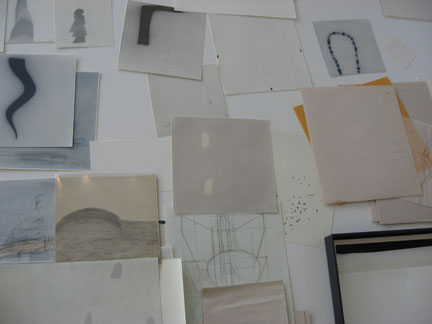 What do the majority of minutes consist of?
What do the majority of minutes consist of?
Hans Rudolf Reust in Dialogue with Silvia
Bächli, Published in: Silvia Bächli – Studio.
Exhibition Catalogue Museu Serralves,
Porto, 2007, p. 141-150; translation from
German: James Gussen
The following questions put by Hans Rudolf Reust to Silvia Bächli were sent and answered by email. Then, on 10 November 2006, a lengthier conversation took place at a beach café in Porto.
Subsequently, the texts were revised.
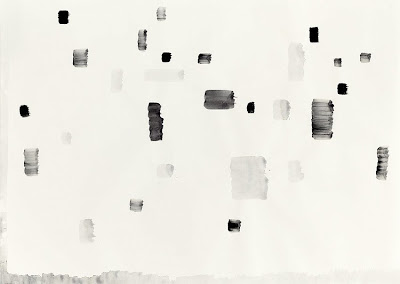 +
+ Viewed over the longer term, your work seems to be marked by a great continuity with a few,
mostly subliminal but enduring changes. This makes the question all the more intriguing as to
whether or not a paradigm change can be distinguished at certain points in your work. As for
instance at the changeover from the constellations of smaller drawings to large formats, which are presented as pictures in their own right. Are there any “key works” that denote important
developments?

++ You’re quite right: changes enter my work quite surreptitiously, they creep in...
Often I only detect the signs in retrospect.
My work develops in a spiral.
Motifs slowly emerge, become more frequent, experience their zenith, pale, and mostly return in a slightly changed form after hibernating.
There are no harsh breaks – although there was one: in 1982 I resolved from one day to the next to stop making diary-like pen and ink drawings in A4 format books. Each book consisted of self-contained stories and observations, and later the individual pages were removed from the books and arranged geometrically in rectangular blocks. Suddenly this was no longer possible, I had to drop the practice. It was getting too one-sided, too narrational. There were repetitions that were getting rather thin. The visual ideas were no more than a husk, without any inner questions.
But essentially the idea of working in periods (pink, blue, cubist, etc.) strikes me as quite absurd. I don’t feel comfortable focusing on one goal.
I find it constricting to make a beginning, to continue the process logically to the end, to conclude it and only then embark upon the next step.
You can never finish anything, at the most look where it’s taking you and how long you can stand it, how long it still grabs you. It may suddenly come to an end, as my experience with the A4 books showed me.
I want the whole spectrum from all around, I want to be able to turn on my own axis.
There are interesting things to pick up on in all directions, everywhere.
There has been one constant from the very start: space.
Good drawings are larger than the format decreed by the edge of the paper.
The drawings are like sculptures, looming to various extents into the space in which we move.
The white walls, the space, are an inseparable part of the image field.
Since that caesura in 1982 I use paper in various whites and yellows, in differing, mostly small to medium formats. The whole range of black and white techniques is allowed.
The finished drawings are hung at differing heights to produce a tight, densely packed score of sounds on the walls.



These clusters remind me of the notation for Gregorian chants.
The simultaneity of things, states, vibrations, etc., corresponds to the way I see my surroundings and what is within me: various levels that mutually colour one another.
I am less and less interested in narratable stories with a beginning and an end.
The ephemeral between the stories, the tone are becoming more important to me, with all their gaps, all that is unsaid, the allusions, the pauses... The stories without a beginning and an end, which cannot be tamed by words.
Beginning with the whole figure, my interest is in homing in more and more on the skin.
The distance is diminishing.
In 1994 I chanced upon another, slightly thicker paper.
That inspired me to give the unsuccessful drawings a second chance by sluicing them with water. The old traces were drowned by the water and covered by new traces.
This response to something that had been there already resulted in far more abstract linear formations, which otherwise I would never have dared to produce.
Playfully I discovered a few forms connected with objects, which I nevertheless can trust.
These works are unable to establish cluster links with one another. They are too similar.
That is why they always hang side by side in a very classical row. These works come in addition to the others to expand the possibilities.

1996: standing in the central room at the Kunsthalle Bern were a number of glazed table display
cases in which drawings from various years had been grouped according to family resemblances:
an attempt at order with fuzzy edges.
This new view of my collection prompted similarities, but also revealed the big differences in what was supposedly the same. Placed next to each other, the ever-returning motifs reveal how dissimilar they are.
Questions can be addressed to the drawings according to concrete criteria (e.g., all “clothing”), as well as painterly (“frayed”) or technical ones (strictly “linear drawings”), or on the basis of formal similarities (“crossed” or “loops”).
Even though kindred motifs emerge among the smaller pictures, I never produce similar works one after the other.
I jump from one idea to the next; every drawing is something different to the one before. It’s simply impossible for me to stick to one single theme.
Repeating something amounts to trying to force something which it is better to allow to happen. Otherwise your thoughts remain stuck and won’t exert themselves.
That at least is the notion, the dogma I cherished for so long – from 1983 to 2000.
It seemed impossible to restrict myself to one area, to one sole possibility.
In the smaller drawings I keep playing games with myself: after a pale drawing I have to do a dark one, or one with unbroken lines. Precise observation has to alternate with the slurring lines of a noise: time and again doing something different to before, without giving up what had preceded, taking everything with you and slowly developing it.
This has been one of my principles over the years.
I want to forget what the drawing with the leg looked like from yesterday – so that I can try it again.

How does it really look?
How does it feel from inside?
How do I see it in other works?
In 2003 I worked together with the publisher Lars Müller on Lidschlag.
The book consists of two hundred drawings from 1983 to 2003.
Each year I put aside 50–150 works from this “fund” into my own collection, the “Lonely Island”. These are drawings which didn’t find a place in exhibitions or that are so contrary I wanted to keep them, as well as works that have a special meaning for me.
So the big challenge was to work through this pile of 2000 drawings and make a selection of 200 to 300, so as to visualise the period from 1983 to 2003 in chronological and linear order as a process of gradual change – leafing through the time.
Cinematic thinking, lines of tension, ease of legibility, movements to and fro, breaks, references to previous works, faltering vortices and calm flow: a montage of images taken from 21 years. For me the project encompassed a completely new (temporal) dimension with infinitely more “words” that were supposed to become “text”.
What had changed over the years?
What had remained the same?
What have I forgotten again, dropped?
How did new things come about?
Have the tonalities changed over the years?
Which story or stories can be told in this way?
Apart from the original drawings, another important aspect of my work over the years has been
the shots I take of my studio.
The photos capture ephemeral constellations and the relations between drawings placed next to one another, which sometimes only lasted the length of a particular work situation.
So one task has been to look through my collection of negatives and pick out informative views.
With the book now finished and in my hand, I can set out on this retrospective.
I have discovered a great deal that had been started, and which could be worked on.
Suddenly I am taken by the idea of daring the impossible and attempting a bolder gesture which would nevertheless be repeatable.
Large paper (200 x 150 cm) demands a totally different kind of physical effort.
One can manage to draw an unbroken line for two metres without interruption.
But a longer movement can only be executed by taking a step and thus by a visible interruption in the line.
Every line must be filled with presence, like a good dancer who extends right beyond her fingertips into space.
Suddenly I can appreciate this new method, and find that the repetition involved in drawing the same again and again is anything but a restriction.
Flower stems become lines, intersecting traceries of lines, parallel bundles of lines.
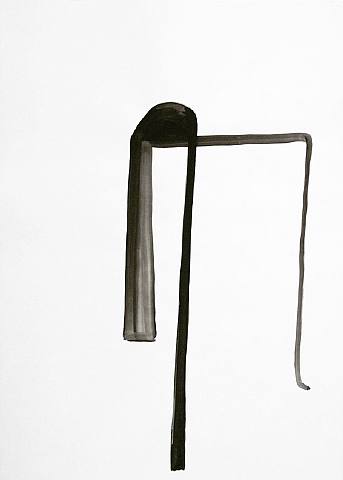
I knew of Agnes Martin when I was twenty-two – only later did I come to appreciate her.
Even if nowadays my drawings often have non-figural cast – they are still closely linked with the
body.
Crossed lines can be stars in the lines on one’s palms, layered up lines are warm blankets
(blankets of snow, of clouds), rectangles with snaking lines are houses and paths, verticals and
horizontals open up a space to see through, step through, a hazy border, a passage. One thinks of
something figural, although none of the drawings point with any certainty to that.
+ Your practice of constantly drawing seems to be directed by a very definite, tuned-in awareness of the world, and not one that is vast and incalculable, but more the understandable world in your closer vicinity. This awareness precipitates into unshakeable images, to stills of other, inner, at any rate, invisible movements...
++ The everyday and normal seem to constantly bewilder me, seem to keep posing new questions:
what do fingers look like? (Study closely.)
What do feet look like under a chair? (Imagine something without seeing it.)
The best drawings are when I can put myself physically into my perception, when I can feel myself into it.
What places are there that can’t be filled out?
How does the back feel? (Looking from within.)
What did I walk past yesterday? (Recalling a route, walking and standing still.)
What do diffuse thoughts look like? (Groping through a fog.)
What does one remember and where are the white spots?
Where does virgin soil begin?
What can be depicted when avoiding sensationalism?
What remains without TV reality, summit conferences and a woman with a heart?
What do the majority of minutes consist of?




My drawings are beams of light cast onto careless, insignificant motions, fusions of objects,
overpaintings of once commenced and since abandoned figurations, noises, notions; continents
between what is closest by.
I allow the furthest extremes to falter and flow next to each other.
Drawing is experimenting, groping one’s way and playing.
My work is like speaking out loud. One tries something, changes the emphasis, tries it with a different sequence of words, at a different volume.
Sometimes a sentence will hit the mark, it captures what you had dimly suspected.
In the best case you discover something that is a better fit, is more surprising than what you had
expected.

Which makes it possible for even words to literally intervene in what happens in a
picture, as in a drawing from 2001: “what / how is / once again / how again / once again / ever
again / and once more”, or in a gouache from 2005: “distant shores / – / old dykes / horizons /
mountains of clouds”, or in another gouache of the same year: “everything is gone / no more / sea/ – / where to / – / come back / sit down / stay here”.
The works have to be “unleashed, but personal to the point of intimacy" (Eva Hesse).
Often the main occurrence is not happening there directly on the paper but more to one side, before or after.
The concern is with traces of a presence that once again becomes ephemeral the moment it is
seen.
An important precondition for this is forgetting.
Because it is only the impossibility of remembering every detail that allows similar questions to be asked again, and with that other aspects be brought to the light of day.
Every work must have something unfinished about it, a possibility for the viewer to join in, slip inside, pick up the thread.
“Drawing is searching for the right tone, for a formulation that rings true, and which I cannot tell beforehand how it will look” – to gently misquote Fernando Pessoa.
In your question you write about “unshakeable” images: Do you mean by that “fitting” images,
ones that have to be, as they are, or do you mean motionless? I tend to see my pictures as if they
could change at any moment, like fickle weather, stop being the same as they were as soon as one
ceases to look for a moment. What had just seemed clear is suddenly dubious.
Drawing is the first, the most important step in your work. But then you begin right away with a
second movement: studying and selecting, and then later with linking up pictures into
constellations.
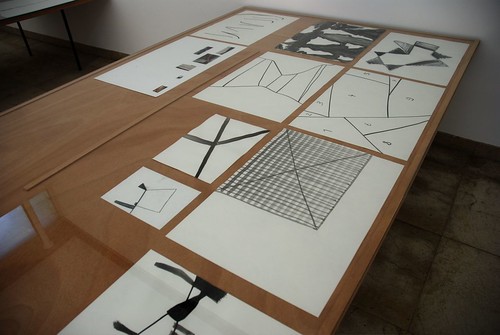
I always have the same approach with the small drawings: draw, leave to them dry, collect them
together and press, then sort them out: the good ones are hung up on the wall, the duff ones
thrown away. The middling ones are put in folder B. With time, some wander from the B to the A
category on the wall, and some from B into the waste basket, and some from A go to B or directly
to C. This method allows me to view and judge my works with a cooler distance.
I only make one or two ensembles, fixed constellations of drawings each year, more than that
seems impossible. If they followed on too quickly from one another they would become too similar.
That doesn’t seem to be the point.
The process of building up an ensemble often takes weeks.
The first three or four pictures I hang up give direction to the work.
Suddenly there is a thread running through them, even if initially the melody I set up is still very unclear and hazy.
A finished constellation is complete when it has a plan for hanging it, in which the heights and the spacing are fixed right down to the nearest half a centimetre.
Finally each ensemble is given a name: alles weg, Solilja, twelf, uma, left sleeve, Drift, L., indisch, abrikosentraeerne findes, Karola, belonging, Ammassalik, för, Tibet, Ida, quittengelb, etc.
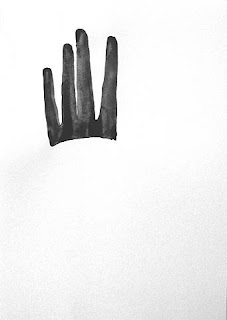
Since these constellations are usually made for very specific spaces, their dimensions are often a
big headache.
The amount of space available at another location never tallies with the ideal, even if
one can put a couple of creases in the large groups.
It is often impossible to hang an ensemble because the wall is too short.
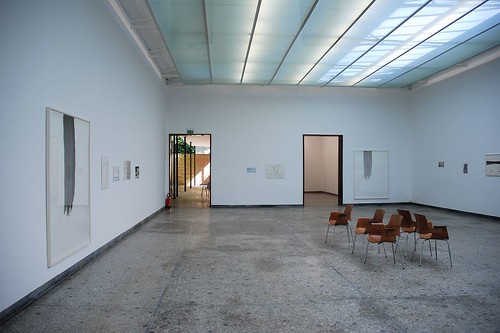
+ With your recent large formats, which have more autonomous play within them, this second
movement of piecing together no longer seems so important....
++ There’s no way you could create constellations with different heights using the large drawings.
In that respect you are right: here one has to stick to making and hanging them up for a certain while to ensure the pictures can also withstand time.
Whenever they are shown at an exhibition they enter new neighbourhoods, in every new situation they have new partners.
The search for the right neighbors is not, however, simply a concern for me with the ensembles, but with any exhibition.
I don’t simply arrive with a couple of works.
I always examine the possibilities for sequences and links beforehand in my studio.
The whole exhibition is already set up in a 1:50 model, and then I check once again at the location whether my proposal actually holds its own with the reality there.
My interest in intervals, rhythms, syncopation, sound intensity, compactions, weight, emptiness – whether inside of an ensemble or in a completely different space with lots of individual drawings – remains unchanged.
Something is missing if one stubbornly hangs my pictures at the same distance to one another.
There should be a correspondence between the drawings and the way they are shown: fast and
slow lines, pausing and dancing, tense and flowing. The drawings go beyond the edge of the paper, which is mirrored by their presentation.
I still regard clearly set plans to be an indispensable help for ensembles with small elements on
different levels.
This precision is not some added extra, but gives the required stringency.
All that is needed with larger formats is a couple of recommendations: hang them asymmetrically, with varying intervals between the drawings...
People who are familiar with the work and have an eye not only for the paper, but also the whole wall and the whole room, will come up with good solutions.

So the constellations of smaller drawings on the walls have been fixed.
In the Kunsthalle Bern you put out tables which each had their own principle of arrangement. Would it be possible to take the same stock of drawings and find different arrangements that were on an equal footing?
I won’t touch an ensemble once it has been put together and given its plan for the hanging. There are two ensembles that offer two possibilities for the way they are hung: Ammassalik and L.
The many individual drawings which are left over from the ensembles can be hung side by side in a line, or arranged in table display cases according to family resemblances.
The arrangement on the table changes from one occasion to the next, and only is settled once it is sold.
Depending on the question involved, a drawing (such as two legs in chequered knee-length socks) may appear on the table “crossed lines” and later on the table “clothes”.
I often develop new families from the same, slightly expanded stock of material for new exhibition spaces.
The list of aspects, which swing between free formal (“frayed”) and figurative approaches (“finger”) is illuminating.

+ Could you add to this list? Are there any more of these aspects?
++ Yes, one could add a number of examples to the free formal ones: brittle / splintery, cloudy,
silhouettes, figure and ground: the alternation between figure as the major element and the white background as leading actor, crossed lines, eights (curls in the form of the number 8), turning inside out, loops.
Or examples of concrete elements: clothes, arms and fingers, zoo, writing, paths, tugging, codes, eyes...
In les ingrédients I worked differently: I took a drawing as my starting
point, split it up into different parts (wavy lines, button eyes, parallel lines, intersections, long
flowing lines), and looked for a new drawing that fitted each of the parts.
The tables are open- ended: they require easily legible as well as very distant forms which would be very difficult to read as still belonging together.
These “far-flung relatives” have to be included so as to avoid a self-contained pigeonhole.
The drawings are to retain their iridescent potential.
It is normal practice to ask about affinities to other artists.
But it is clear that our generation in particular does not wish to get bogged down in debates about programmes.
But that is why I would be particularly interested in what you resolutely dislike in art, what you reject, where you mentally draw the line.
What I resolutely dislike is virtuoso art that is nothing more than that: accomplished, but hollow
and empty.
This superficial virtuosity is too informed.
And I don’t like pathos or people dully chewing over the realities in the media, sex and crime. I’m also uninterested in headlines and current affairs. I similarly dislike having to confront kitsch through the means of art.
Art doesn’t have to physically overwhelm me.
Expressive screaming has to measure up to the subject that is depicted.
What I find really appalling? When people are enlisted to perform seemingly voluntary
actions which they otherwise would never do; or art that wishes to show us the vileness with which we apparently treat one another; or voyeurism, spoon-fed to us in the protected sphere of an art space.
What really puts me on edge: this mostly roundish-oval, organic, abstract commonplace language.
The Idiom has already existed for some time, and keeps on cropping up: wadded, harmonious,
beige, slightly melancholy, but with a large serving of snugness; accompanied by unclear,
imprecise verbiage in the most general terms.
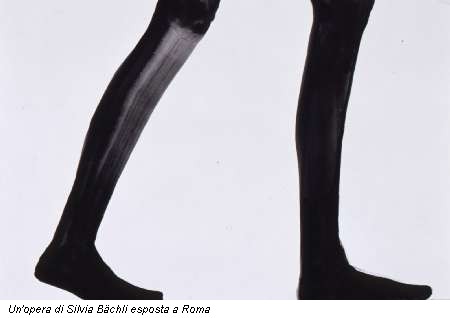
“How” is more telling than “what”.
The way something is made, the approach that informs it, is
more decisive than the chosen motif.
I am drawn more to a Romanesque chapel than the Sistine.
Sweeping barren landscapes – Iceland for example – with their primal emptiness fascinate me far more than tropical regions.
Drawing means leaving things out: a winter landscape with snow.
other texts on her work:
silviabaechli






